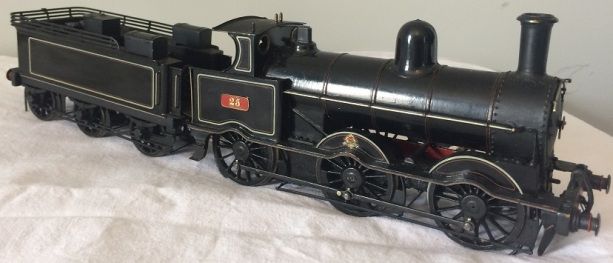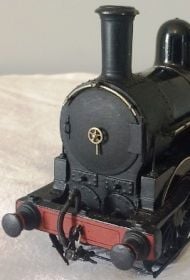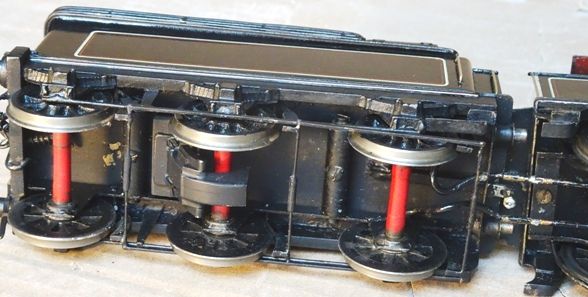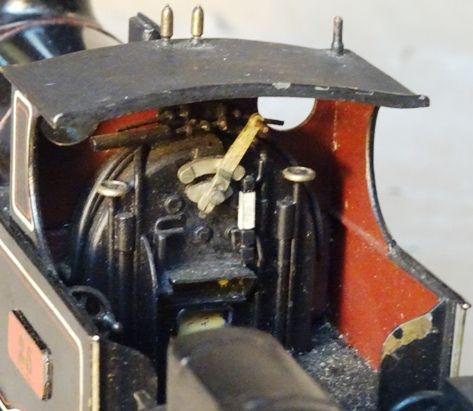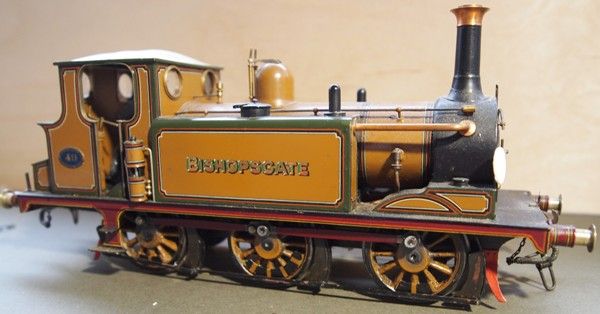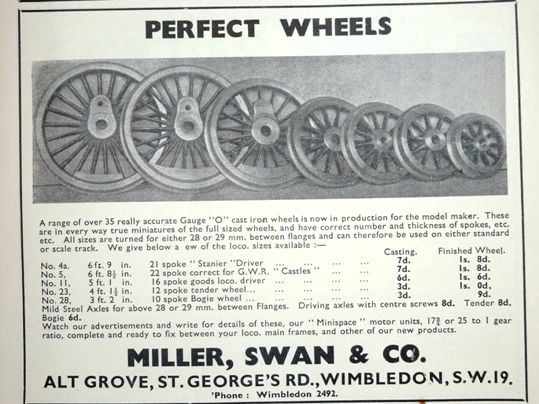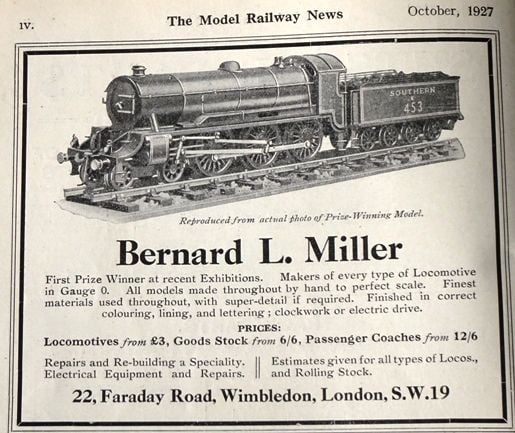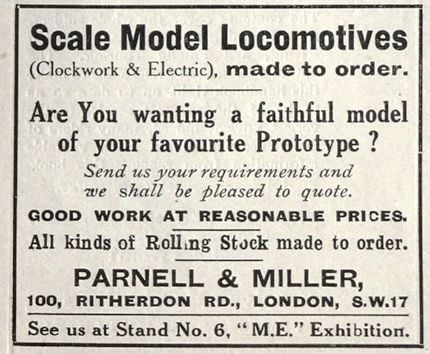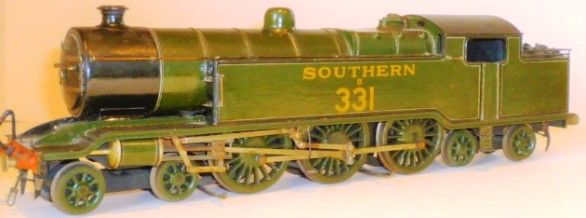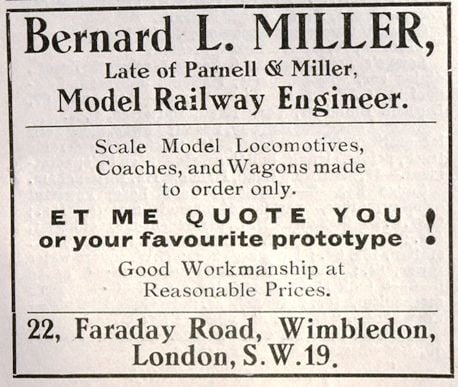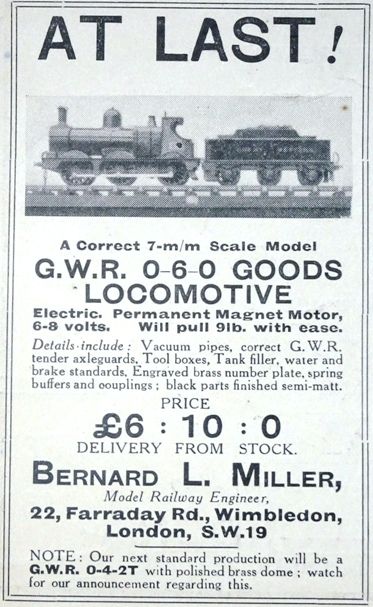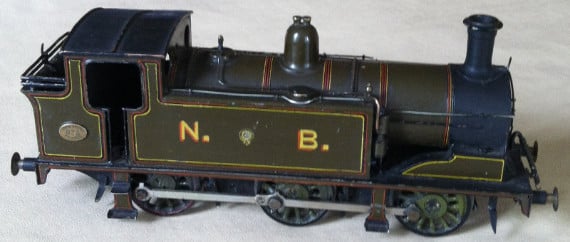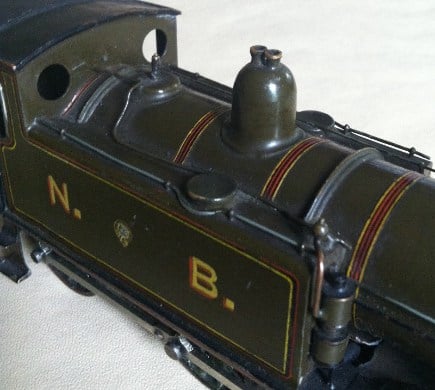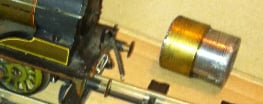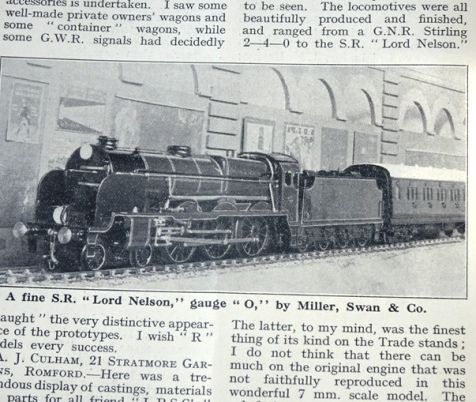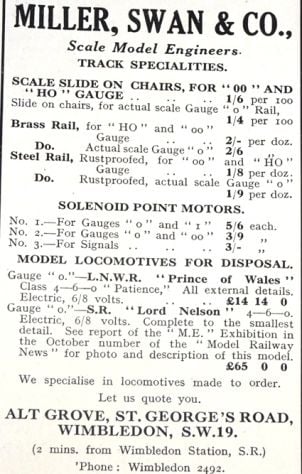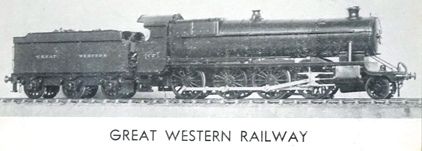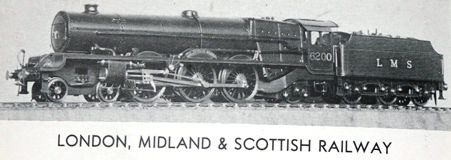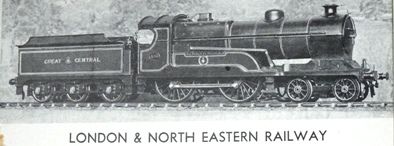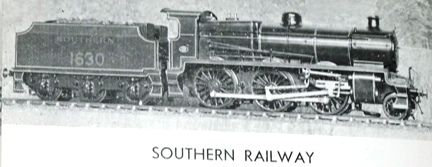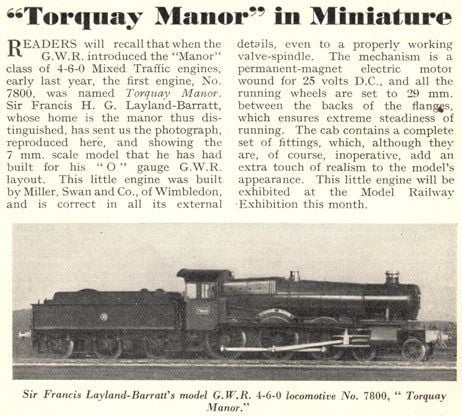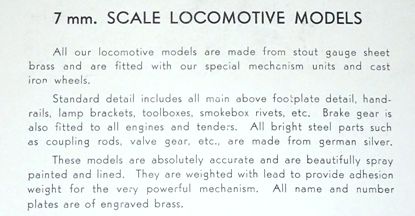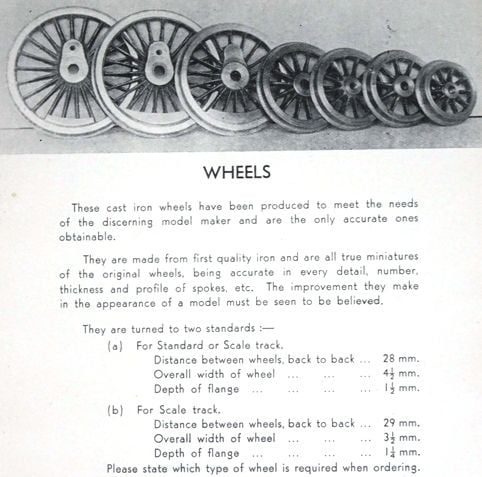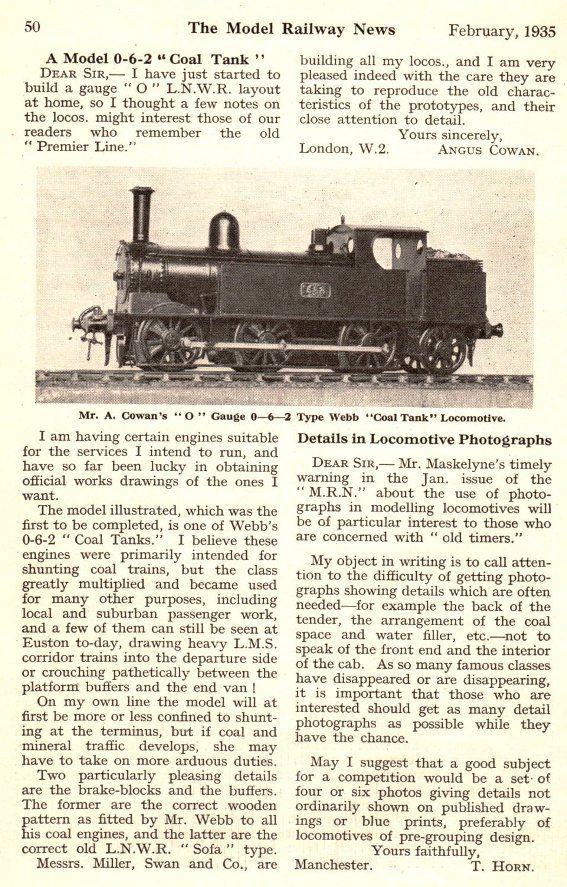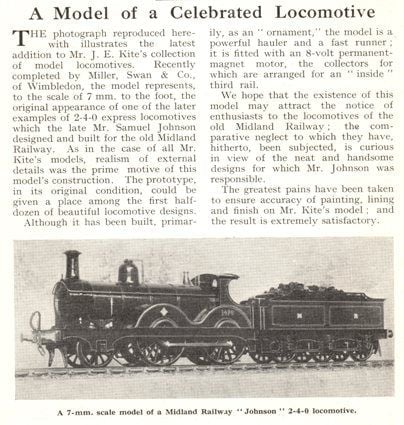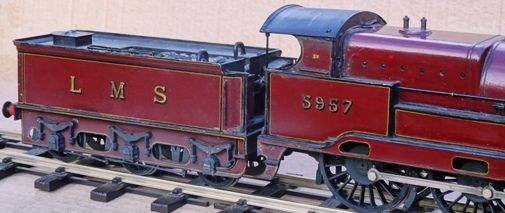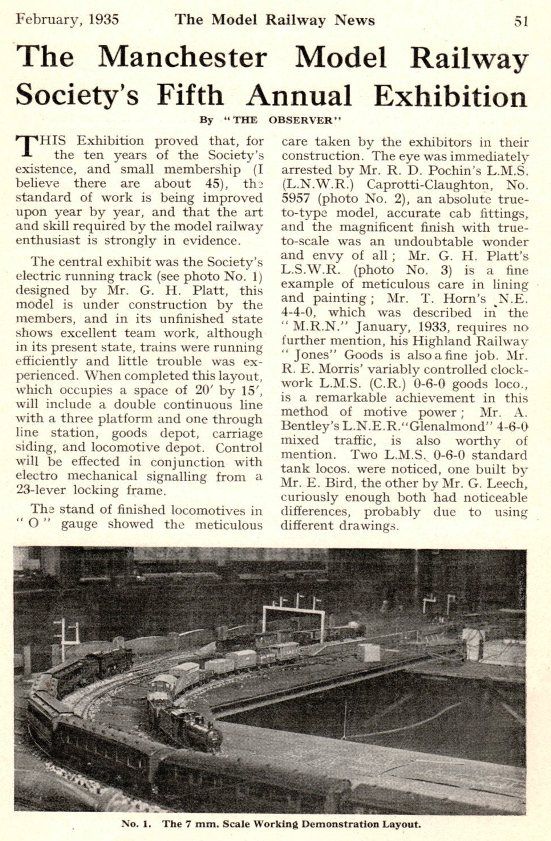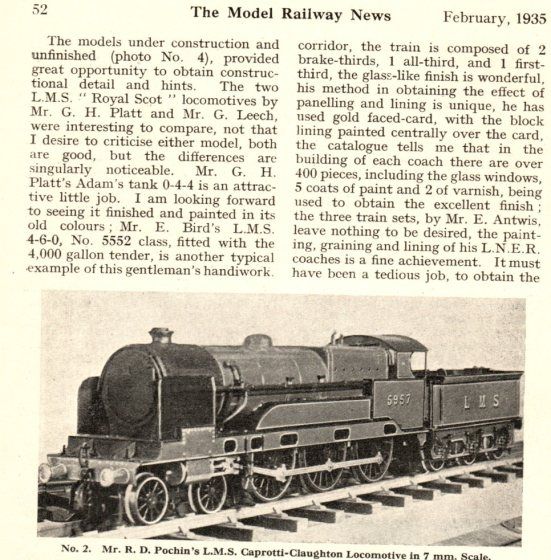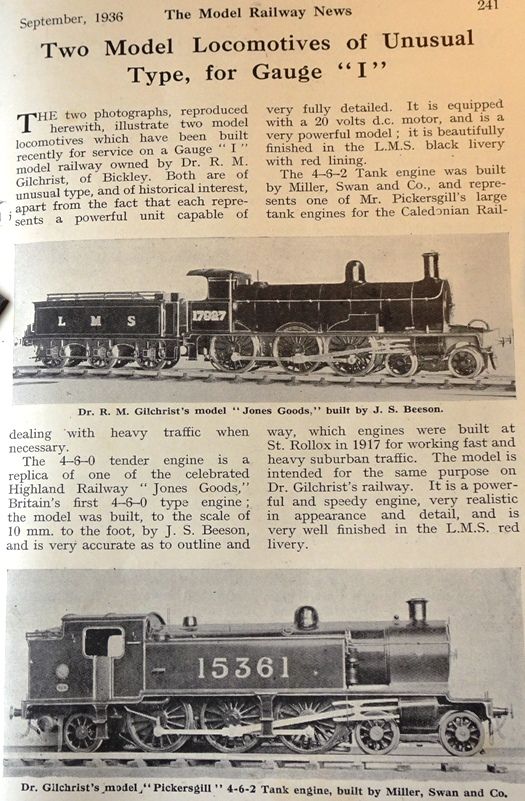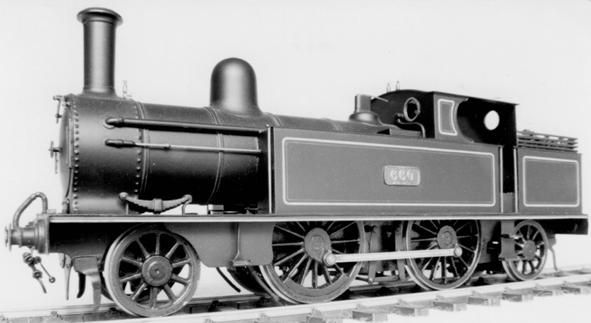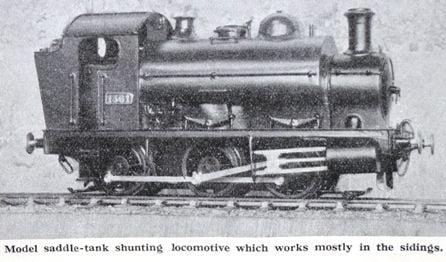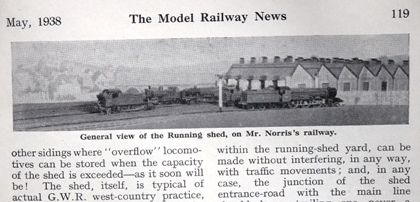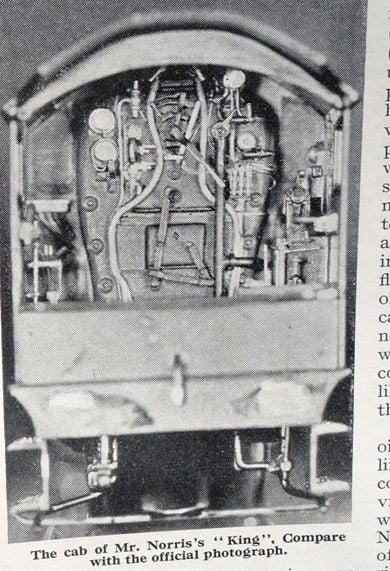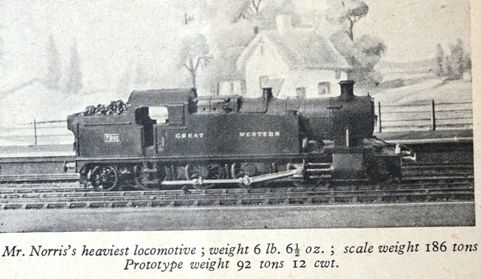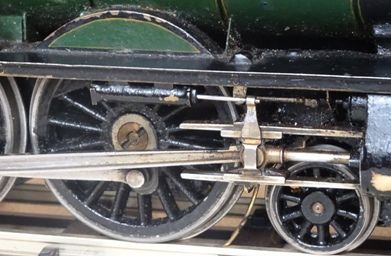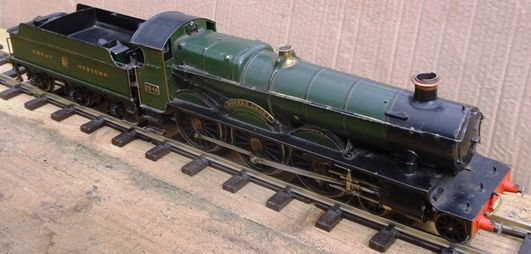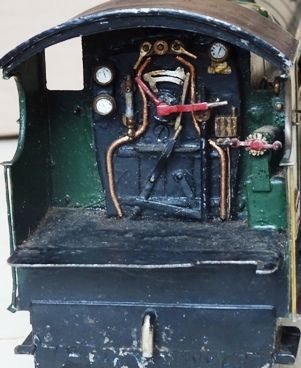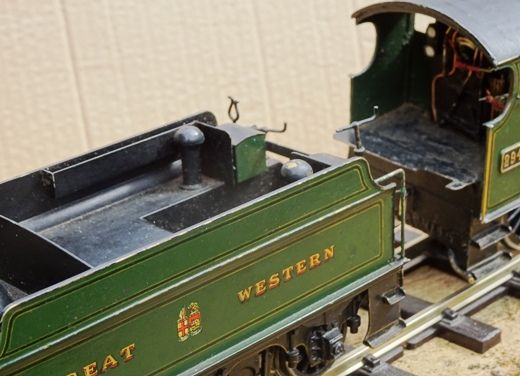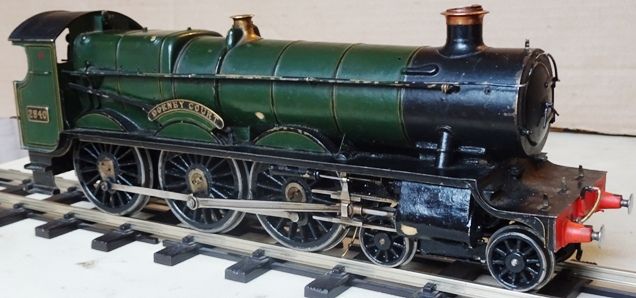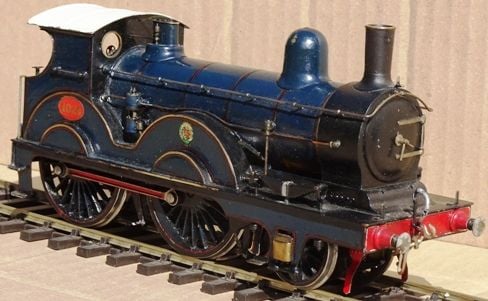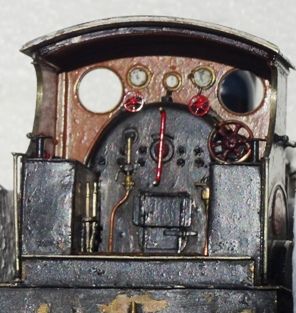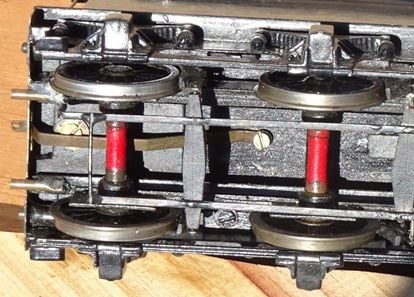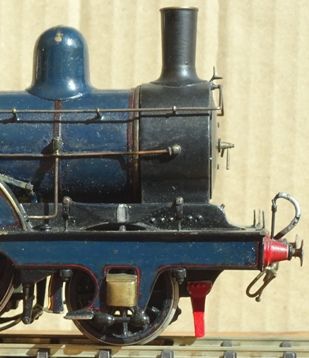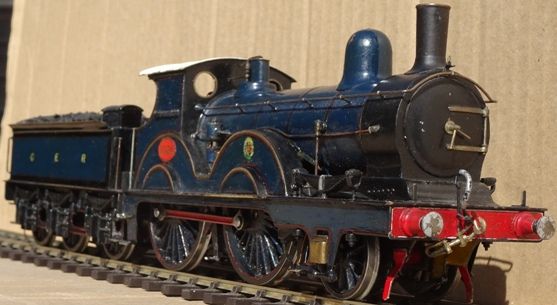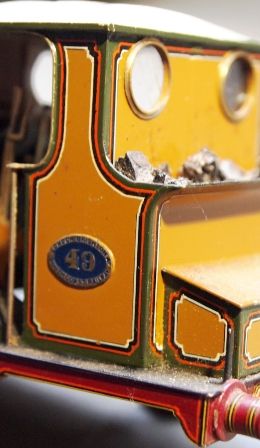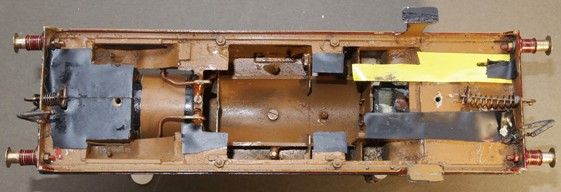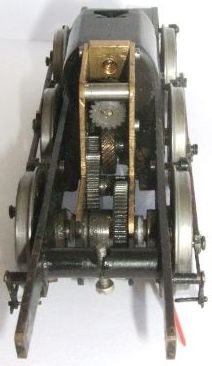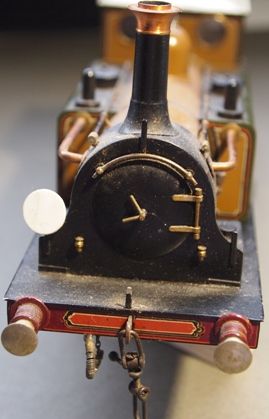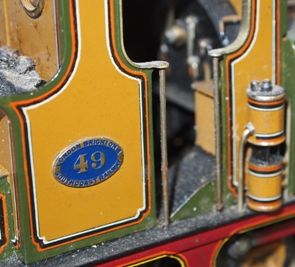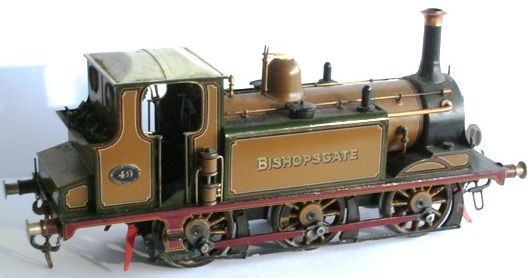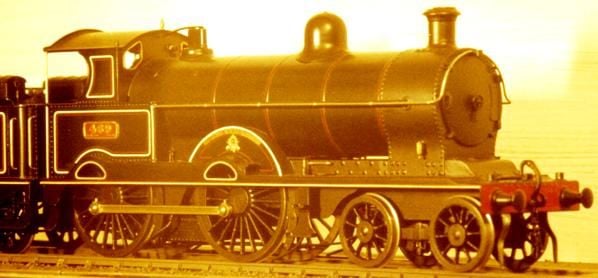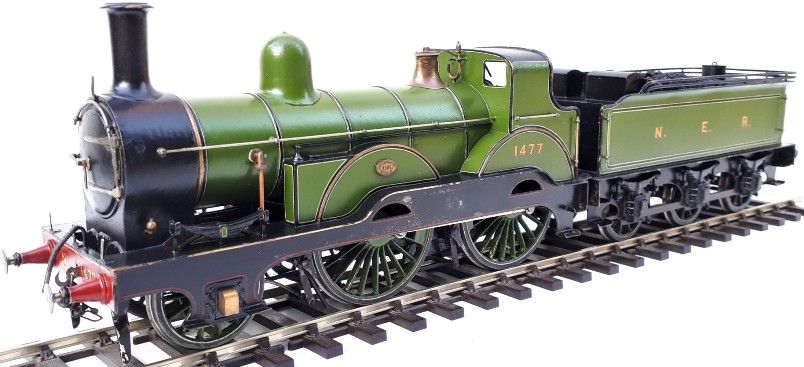
Miller Swan & Bernard Miller
**** This material was updated most recently at the end of April 2025 ****
Bernard Miller's model-making with particular reference to 0 gauge locomotives Author's note; please do not borrow or reproduce the written material or photographs from this section without my permission. I hope I have not cut across anyone else's copyright in reproducing printed images below, and apologise if I have done so, but most of the items involved are now more than seventy years old. I am of course happy for anyone to print out copies of my material for private use, as this website aims to provide information free for enthusiasts who might be interested. Copyright is retained by M.L.Harrison for all text and photos, except for those taken by other owners, photographers and enthusiasts. M.L.Harrison 2020 © All rights reserved.
Illustrations BM1a-BM1c. LNWR 'Cauliflower' 0-6-0 tender locomotive no. 25, by Bernard Miller. I am grateful to the person who took these photos for permitting their use here. A recent author J.E.Emerson (see below) indicates that this engine was built by Miller around 1928-30 for Angus Cowan, and exhibited at Central Hall in Westminster a decade later. It was apparently re-wheeled by W.S.Norris when owned by him. The model has subsequently had five other careful owners. I do not know what mechanism it might have had before Norris acquired it. The Miller Swan & Co. catalogue from the late 1930s included in its LNWR list a 'Cauliflower Goods Loco' (0-6-0), at a price of £21 10s. This one is apparently made of brass.
Illustrations BM1d-BM1e. Two more photos of this model, showing the underside of the tender (with electrical connections visible), and the realistic cab detail. This LNWR model ran on the famous Norris finescale two-rail layout, and can be seen in that setting with a goods train in one of the photographs accompanying Ray, J., 'The Treasure House in the Garden; The Remarkable 0 Gauge Empire of W.S.Norris' (The Model Railway Journal, 43, Christmas 1990, page 625). Many thanks to the person who alerted me to that journal article, and also sent me extracts from Norris correspondence published in the same journal in 2018. The loco is also one of several featured in coverage of Bernard Miller by Jack Ray and John Miller in 'Bernard Miller; the man behind the maestro', and 'The moody charmer' in The Model Railway Journal, 59, Christmas 1992. I am grateful to the person who very kindly sent me that issue of the journal, which seems to contain one of the best arrays available of published photographs of Miller engines. Additionally, this 'Cauliflower' is included amongst the many items shown in the outstanding Gauge O Guild slide collection issue on the Norris railway (see below). Illustration BM1f. Many thanks to the owner of this very handsome loco, and to Andy Nicholls, the photographer who took this picture and some others of the same tank engine that are shown later below. Bishopsgate is a Miller engine that was featured in the model railway press. A large photograph of the loco appeared on the cover of the Model Railway Constructor in February 1979 (46, 538, front cover). The editorial caption inside the magazine attributed this 'Terrier' incorrectly to J.S. Beeson. The picture above shows the locomotive very much as it appeared on the cover, and details are identical (except for the coupling rods which have been reversed). We say more about this model below.
Bernard Miller is probably much less well known than J.S.Beeson amongst today's 0 gauge model railway enthusiasts, but his impact on railway modelling in the UK was very considerable. He has been considered by enthusiasts and experts who have described his work as an extraordinarily gifted and committed artist-craftsman, who took great care over his modelling, and made engines that bore a very close resemblance to their prototypes. Much of the published writing touching on his activities is concerned with the development of the model railway layouts of W.S.Norris, in which Miller played important roles. Unfortunately, beyond this there seems to be relatively little published detail available about his models and their production, either in books or on the internet. Furthermore, as time has passed, the group of model-makers, enthusiasts or collectors who knew him and his work directly has begun to diminish. This section therefore attempts to provide a brief readily-accessible starting point for readers interested in his locos who do not know much about him. The aim is to help place Miller's engines in the broader context of vintage trains and their development and production. I hope to add some more detail about specific examples of his work later on (if I have the opportunity to get some effective research done). I am very grateful to the people who responded to the first drafts of this essay, and some enthusiasts clearly have had an impressive depth of knowledge and investigative commitment when approaching Miller's work (and that of Norris). I am especially grateful to Peter Davis and Mike Williams, who know a great deal about Miller's engines and the Norris layout, and have very helpfully filled in parts of the history for me. Mike has let me see information gathered some years ago that identified and tracked a number of the engines known to have been supplied by Bernard Miller, or by the firm Miller Swan. I have not seen anything similar to this research amongst the reported works of other model railway enthusiasts or historians, and have included it as an important source at the end of my list below. I should add at the outset that I do not have any prior personal technical knowledge, insights or expertise in relation to Miller's modelling work, so the commentary below is mostly kept fairly general (and is occasionally speculative). What follows here is in effect simply an introductory essay on Miller, offered tentatively in a situation where there is no existing book comparable with those covering Bassett-Lowke, Beeson or the Leeds Model Company. I have tried to reference as many sources as I can, to enable others to make their own enquiries in more depth and with greater precision if interested.
Available sources From the limited search I have carried out so far, it seems that the best available illustrated sources on Miller's activities as a model-maker are the excellent historical contributions made by the late Jack Ray. Some of these form parts of the wide-ranging records of modelling and layout construction and operation built up by the Gauge 0 Guild (GOG) over many years. Particularly valuable are two sets of slides, accompanied by very well-researched commentaries by Ray. Thanks to the efforts of officers responsible for the GOG slide collection, these records were saved and brought up to date in the form of DVDs (see also our acknowledgements in this site's Home Page). One is directly about Miller, and contains numerous examples of his locos and rolling stock. The other reviews the finescale two-rail layout of W.S.Norris, with which Miller had been heavily involved. For this account, Jack Ray gathered an impressively large amount of information and material from individuals, and deployed images from a variety of sources. The above material can be supplemented from coverage by Jack Ray and John Miller in a Model Railway Journal issue in 1992, 'Bernard Miller: the man behind the maestro' and 'The moody charmer' (see list below), together with journal articles and press reports related to Norris over many years, and some recent writing about him by Emerson (see below). To add to these sources, I will draw on a catalogue from Miller Swan & Co., and a range of illustrative press items relating to Miller in the 1920s and 1930s, as well as after the war. The early model railway press advertisements noted in the main text below provide a slightly different account of Miller's commercial activities from that included in the more modern journal coverage, and I hope might interest even those who know Miller's models far better than I can hope to do. Unfortunately, at time of writing I do not have complete coverage of The Model Railway News in the 1930s, so there may be some important items I have not yet seen. Cowan, A., 'A Model 0-6-2 "Coal Tank" ' (letter), The Model Railway News, February 1935, 11, 122, page 50. Ellis, Hamilton, 'Model Railways 1838-1939', Allen and Unwin, London, 1962; see photographs opposite pages 97 (two Miller engines from collection of J.E.Kite), and 136 (two pictures of the Norris 2-rail layout). Emerson, J.E., 'The Norris Layout: the New Deal for 0 gauge', 2017, sourced 2019 at https://www.lynxmodels.net/norris.html, Revised version of a Supplement published in August 2011 by British Railway Modelling as 'Layout of a lifetime. The new deal for O gauge: a pictorial look back at the pioneering 7mm finescale layout of W.S.Norris', 16 pages. I am grateful for help with this reference from Graham Thomas, who has extensive knowledge of publications relating to Norris. Essery, B. and Wright, T., 'British Railway Modelling: a century of progress', a British Railway Modelling Publication, undated. Faculty Publishing, 'Masterbuilders Millenium 2000', Calendar featuring model locomotives by Beeson, Miller, Reynalds, Green, Everton, and Leeming, 1999, Faculty Publishing, Poole. Includes a very large picture of 1930s Miller model of MR 4-4-0 Beatrice (and inset photo of detail inside cab) plus coaches; and a very large picture of Miller model of SECR 4-4-0 Wainwright Class D, with a brake van. Gauge 0 Guild, Slide collection, Ray, J., 125 and 126, DVDs on Bernard Miller and The Stanley Norris Railway. These are key historical records researched and put together by Jack Ray with great skill and attention to detail. Levy, A., 'A glimpse of fine scale', A Century of Model Trains, New Cavendish Books, London, third impression, 1978, pages 178, 180-183. Maskelyne, J.N., 'The Model Railway Exhibits at the "Model Engineer" Exhibition, 1932', The Model Railway News, October 1932, 8, 94, pages 255-266. [The Model Railway News] Maskelyne, J. N., 'Mr. W.S. Norris's "0" Gauge Railway' - (1) to (5), The Model Railway News, April-August 1938, 14, 160-164 [various pages in five successive issues of the journal carrying the installments]. [The Model Railway News] Maskelyne, J.N., Photograph of a GWR Aberdare loco and short report indicating it had been on loan to the Norris GWR layout. The Model Railway News, August 1942, 18, 212, page 174. Maskelyne, J.N., 'A new deal for 'O' gauge' (Part I, 'Preliminary', and Part 2, 'Comments on Track'), Model Railway News, February 1960, 36, 422, pages 41-45; and April 1960, 36, 424, pages 140-143. Part 3, 'Locomotives and Trains', Model Railway News, June 1960, 36, 426, pages 219-221. Part 3 had useful images and commentary, including observation that 24 out of the 25 locos then running on the Norris 2-rail layout dated from the earlier days of the 3-rail layout. This did not include any of the GWR locos, which had been disposed of. These three reports were followed in May 1961 by a fourth piece, written by Norris himself, following the death of J.N.Maskelyne (see below). Miller, Swan & Co., scale model engineers, Catalogue; 20 pages, undated (but probably 1938 or 1939). Norris, W.S., 'Weight in Model Locomotives', letter to The Model Railway News, May 1944, 20, 233, page 104. Norris, W.S., 'In Praise of 7mm. Fine-scale', The Model Railway News, May 1949, 25, 293, pages 90-94. Norris,W.S., 'The replanning and rebuilding of Britain's finest layout', a project by W.S.Norris, Model Railway News, June, 1957, 33, 390, pages 143-147. NB ... Norris did not choose the over-assertive description of this title, and the subsequent issue of the journal contained a letter from him explaining that he would not have claimed that anything of his was 'the finest' (p. 182). Norris, W.S., 'A new deal for '0' Gauge', Electrical notes by W.S.Norris, Model Railway News, May 1961, 37, 437, pages 161-164. Norris, W.S., 'Letters from W.S. Norris', Model Railway Journal, 2018, 265, pages 239-241; 2018, 266, pages 277-280. Ray, J., with Cross, M. and Stevens, J., 'The Treasure House in the Garden; The Remarkable 0 Gauge Empire of W.S.Norris', The Model Railway Journal, Christmas 1990, 43, pages 618-626. Ray, J., 'Fifty Years Along the Line, 1956-2006', The Gauge 0 Guild, 2006, pages 57-58. Ray, J. and Miller, J., 'Bernard Miller; the man behind the maestro', and 'The moody charmer', The Model Railway Journal, Christmas 1992, 59, pages 282-292. There are also probably useful items in issues of the Gauge 0 Guild's Gazette, but at time of writing I have not had an opportunity to research these. Quite a few other small comments or pictures are scattered across books and journals, but it would require an exhaustive search to gather them (one interesting example is the photograph of the Norris three-rail layout opposite page 71 in Carter, E.F., The Model Railway Encyclopaedia, Burke Publishing, London, 1950). *** Williams, M.R., (unpublished/undated, but written in early 1990s or thereabouts), 'Locomotives built or rebuilt by Bernard Miller'. This is an impressive and solid report compiled from a variety of sources by its author, listing and commenting on locomotives known to have been built or rebuilt by Miller, or associated with him in previous comments by others. It reflects distinctive research covering the period from the time when Miller first sold models until the last years of his model-making. I do not know of comparable research carried out by anyone else on locos made by a British 0 gauge builder, and am very grateful for being able to see this work.
Miller as a pioneer Bernard Miller is generally regarded not only as having been an outstanding modeller, but also as one of the key UK pioneers in developments towards finescale modelling. One of Jack Ray's photographs shows a loco built in 1928 that was apparently the first finescale engine Miller made. It seems he would have been only twenty years old at that time (having been born in 1908), but Bernard Miller began modelling early in life. As one informant confirmed to me, Miller was very young when he set out to make models for a living. Although when the term finescale is used it sometimes becomes associated with high levels of detailing on locos and rolling stock, 'finescale' relates more directly to the dimensions of wheels and the realism of the track. Certainly, a finescale layout today would be expected to have much more realistic track than the heavy duty kinds sold by the major suppliers of the pre-war vintage years, and the locos would now have slimmer wheels (and a different back-to-back distance between wheels when fitted onto an engine). Already, before the second world war, Miller was not only building some very accurate model locos, but also trying to market fine-scale track and a choice of wheels with differing dimensions (see advertisement reproduced below, Illustration BM2). Beeson, meanwhile, seems to have worked in this period primarily to what was referred to as 'standard scale', in line with the more mainstream parts of the commercial environment. Good summary coverage of debates around coarse scale and finescale is provided by Essery, B. and Wright, T. in their attractive book 'British Railway Modelling: a century of progress' (a British Railway Modelling Publication, undated, pages 31-34, 43-44, 65). Their coverage also includes some material on the finescale two-rail layout of Norris (with photographs), and a portrait picture (at page 61) of one of Miller's 3-rail tank locos (a GNR 0-8-2) that can be seen at the National Railway Museum at York.
Illustration BM2 In the 1930s Miller was a pioneer in the production of wheels and track that were true-to-prototype. In this advertisement he caters both for 'standard' and 'scale' operation. I have enlarged this advertisement (and others below) to make things easier to read. See The Model Railway News, June 1938, 14, 162, page vii. Alongside the focus on track and wheels, Bernard Miller also sought to create models that represented the full-sized prototypes as accurately as possible, and that involved a great deal of inevitably time-consuming work. This has to be seen against the backcloth of the UK model railway environment of the 1920s and 1930s, when the 0 gauge commercial market was focussed primarily around selling trains that were simplified in various ways, but ran impressively (on very solid track that enthusiasts could set up easily), and could be bought by substantial numbers of people at affordable prices. Not only was this a competitive market, but it was affected by the severe economic difficulties of the economy over much of the period. Despite these factors, Miller provided what must have been some relatively wealthy customers with superb models capturing key characteristics of the originals. Even in his very early days as a maker, he seems to have undertaken commissions where he took immense care in the cause of accuracy. A knowledgeable informant has told me, for instance, that for one of the finest of the early models (the LNWR loco, Jeanie Deans), Bernard Miller made the outside valve gear using original Crewe drawings. If we look a little later, to the images of hand-built engines shown in the Miller Swan catalogue (see the four reproductions below), it can be argued that we see displayed what are amongst the most convincing catalogued locos offered by any of the main UK 0 gauge commercial builders in the pre-war decades, apart from a few 'special order' super-detail engines offered from time-to-time. Caution is necessary, however, before assuming that these Miller Swan models or earlier known masterpieces were entirely typical of Miller's output from the late 1920s to 1939, and our brief historical review suggests more diversity. As will be seen later, Bernard Miller's path-breaking model railway work with W.S.Norris received a great deal of attention, particularly in respect of the Norris finescale two-rail layout. That focus has one slightly unfortunate consequence from the point of view of anyone today trying to study Miller's locos from published material. Most of the engines modelled or rebuilt for the two-rail layout were in pre-grouping liveries and were relatively small, as well as being highly accurate copies of the 'real thing'. They give little visual clue to the character of any larger post-grouping engines Miller built in other periods or for other clients, or about any engines sold with less detailing. It seems that they were also 'standardised' to some degree from the point of view of running (with changed motors, etc.). In the published photographic record accompanying reviews of the later Norris layout, only a GWR King (built in the 1930s but eventually converted to two-rail) provides a contemporary visual example of a larger post-grouping engine.
Development of Miller's commercial activities as a model-maker The first task is to try to create an impression of Miller's commercial model-making activities as they developed through the pre-war years, noting his stated intentions, priorities, prices, and positioning within the model trains market. As far as I can ascertain from limited sources, Miller seems to have started advertising nationally as a commercial supplier during the second half of the 1920s. In September 1927, a small notice appeared in the "Trade Announcements" column of The Model Railway News, indicating that B.L.Miller would make Gauge 0 Scale model locomotives and rolling stock to order at competitive prices. Additionally, rebuilding and repainting were "a speciality" (3, 33, page x). This entry most likely would have been one of Miller's first pieces of national advertising. A month later it was followed up by a much more impressive half page advertisement in the same journal featuring one of his models, a Southern 4-6-0 no. 453. This had apparently been a prize winner "at recent exhibitions" (3, 34, page iv; see Illustration BM3 below). The advertisement offered models made throughout by hand "to perfect scale", and (if desired) these could be super-detailed. Prices mentioned included locomotives from £3, and Miller would build for electric or clockwork drive. By way of comparison, we can note that in September Bond's had announced their small 'Bonzone' 0-6-0 tank loco at 35/-, a modest but very neat model (at this time offered in clockwork). It is not clear exactly what was available from Miller for £3, but in comparative terms the price he mentions might seem relatively modest, since firms like Bond's were building batches of models on a scale that would have been far more economical than creating single 'to order' locomotives.
Illustration BM3 It appears that from the outset Miller intended to set himself an agenda of high-quality work, and the model used for illustration above is impressive for its period. Expectations for the coupling rods, etc., perhaps would have been more modest in 1927 than later in the 1930s. Soon after this, Miller seems to have gone into partnership with L.R.Parnell, and their joint advertisements appeared for some months in The Model Railway News during 1928. A loco produced by Parnell and Miller has been described to me by a leading expert on vintage models who examined it. I understand it was made of tinplate and fitted with a German electric mechanism. Illustration BM4a This is an enlarged version of a Parnell and Miller advertisement placed in the Model Railway News in June 1928 (4, 42, page x). This business relationship apparently did not last long, for in November the former partners placed their own 'solo' advertisements in the same journal. Each described himself then as being late of Parnell & Miller. Parnell's advertisement (shown immediately below) took a full half page and featured what was treated as one of his own models (a large SR tank engine). Miller's advertisement was much smaller and less distinctive.
Illustration BM4b. Parnell's advertisement. from The Model Railway News, November 1928, 4, 47, page vi.
Illustration BM4c. I am very grateful to the photographer who sent me this picture of what seems likely to be the same model as the one in the advertisement above (or one of a pair if a second was made). I understand that it carries a maker's label from Parnell. The engine appears to have survived very well.
Illustrations BM4d and BM4e. Many thanks to the enthusiast who has supplied these pictures of a fine Parnell model of an LMS pacific. We showed some other photos of this engine (provided by the same photographer) in our website page on Locos by Other Makers. The model has been associated with Leeds Model Company, as an item believed to have been supplied through them as a commissioned order after the second world war. I have been informed that the maker was the same Parnell referred to above, who worked with Miller in the early years. His label can be seen clearly underneath. I do not have any other information to verify or comment further on the partnership.
The Miller advertisement below has been reproduced below considerably larger than the original in the journal.
Illustration BM5. Miller's advertising after the partnership ended; from The Model Railway News, November 1928, 4, 47, page xi.
By the end of the 1920s, Miller was advertising in the Model Railway News as 'Bernard L. Miller, Model Railway Engineer', operating from Wimbledon premises, and offering Gauge 0 scale model locos, coaches and wagons, made to order only. Although his advertisements usually look smaller and perhaps less enticing than Beeson's, they do indicate emphases and developments. In January 1929 he included a small illustration of a GWR prairie tank (The Model Railway News, 5, 49, January, p. viii). In August that year he referred to being 'specialist in 0 gauge' (5, 56, p. vii), but in December he was described as specialist in Gauges 0, 1 and 3.5 mm, and had added permanent way and accessories to his offer (5, 60, page x). The claim at this moment was for "First-class workmanship at reasonable prices". It is worth considering what part of the market Miller was aiming at, and the prices being charged. Given the extremely difficult economic conditions of the late 1920s and early 1930s, comments interpreting prices at particular moments must be cautious. We can see, however, that the competition in 1929 included advertised Windsor Models GWR tank locos at £3-10s to £4-10s, and these would have been soundly made and good runners, even if fairly plain. Perhaps a reasonable guess might be to say that Miller would have been working somewhere above standard Windsor Model prices for his prairie, but perhaps not yet up into the highest priced territory Beeson had begun to occupy. Nonetheless, Bernard Miller was aiming at accurate scale modelling, and this was confirmed the next year when his February Model Railway News advertisement included a small picture of a GWR 0-6-0 goods loco described as a "correct" 7mm scale model (6, 62, p. ii). The headline for this advertisement was "AT LAST", perhaps in effect implying higher standards of representation than many of the commercial models of this period (see Illustration BM6 below, which geatly enlarges the advertisement). The loco was offered "from stock" rather than to order, for £6 10s, and it was announced that the next "standard production" was to be a GWR 0-4-2 tank loco with polished brass dome. The 0-6-0's details apparently included vacuum pipes, correct tender axleguards, tool boxes, tank filler, water and brake standards, engraved brass number plate, and spring buffers, with black parts "finished semi-matt". There was no mention, however, of rivet detail.
Illustration BM6. Our reproduction here gives a much enlarged image, as the original advertisement was relatively small (The Model Railway News, February 1930, 6, 62, page ii).
The focos on selling GWR items in particular can be seen again in December 1930, when Miller's advertisement began with the heading "GREAT WESTERN RAILWAY", and referred to a large 0 gauge prairie tank for £6 10s. Again, the promise was for good workmanship "at Reasonable Prices" (6, 72, p.x). This advertisement mentioned gauges 0 and 00, with either clockwork or electric offered in 0, but only electric in 00. Miller also stated that "old types" were a speciality. It seems that the creation of older classes of locomotives remained significant for Miller in later periods, and conceivably this might be one reason why there are relatively few published pictures of larger post-grouping tender locos made by him (apart from his own catalogue images and the photos of GWR models from the pre-war Norris layout). Interestingly, however, a report from 1932 notes that Miller had made some modern French engines along with models of 'old locomotive favourites' (The Model Railway News, 8, 89, May 1932, page 138). In 1931 Miller moved to new and enlarged premises in Streatham Common (London SW16). His advertising indicated that estimates would be given for making all types of locomotives in Gauge 0 (and the firm would also make station layouts in 0 and 00 gauge) (The Model Railway News, 7, 77, May 1931, p. ii). In October he again emphasised "REALISM" as the heading of his small advertisement (7, 82, page xi), and referred to making "high-class scale model locomotives, clockwork or electrically driven", as well as rolling stock and permanent way. Models were now apparently supplied to order only, were to be "fully guaranteed", and were "beautifully finished". It seems plausible that Miller was now seeking to build at relatively high standards as a matter of course, although perhaps with exceptions when responding to demand. Perhaps aiming at a rather similar part of the market, Beeson explicitly included offers of cheaper models (in relative terms at least) alongside his higher grade ones. A contemporary Beeson advertisement even refers to some LMS 0-6-0 tank locos from what he called his "New semi-mass production line", pricing them at £7 17s 6d post free (The Model Railway News, 7, 81, September 1931, p. vii; see also our section of this website about Beeson's locos). This is a reminder of the impact of market necessities even for the best UK makers, with conditions considerably worsened by the overall economic climate. It is important to emphasise that customer expectations about the detailing of models for the majority of enthusiasts in the early 1930s were different from those of today's 0 gauge modellers. On rivet detail, for example, attitudes shifted over time, but slowly. Before World War Two, rivet detail was rarely represented on the 0 gauge model railway locos of the main UK commercial firms, although it was sometimes included on the more expensive models, especially perhaps for some of those built to order for wealthy buyers. The most highly skilled of the smaller model builders (including Beeson and Miller) certainly might provide this level of detail, but it would take time and increase the cost of models. Before the war, Beeson - as the loco images in his advertising show - did not add rivet detail as a matter of course even to some of his better engines. Less is known about Miller's practices, but (in the absence of fuller information) I would guess that through the 1930s he sought to enhance the level of detailing generally achieved on his models as he prioritised realistic representation, and perhaps 'super detail' models would have been his preferred commissions. Yet issues of time, cost, and variation in customer priorities would have meant at the very least some Miller engines being made without any rivet detail, and probably still more without interior cab detail (or with only a limited amount of it). Even so, I believe that Miller was a key pioneer amongst commercial producers in adding rivet detail, and that he achieved a compromise solution on this as his standard practice some time in the 1930s. Thus he would represent rivets on the front of a locomotive (particularly on the smokebox), but not necessarily elsewhere. We say a little more on this below. No doubt there would be some engines with fuller detailing, but they would most likely be very expensive commissions.
An early tinplate Miller model, originally built for clockwork running The three pictures below show what seems to be an example of a relatively early Miller model, made in tinplate for clockwork running, and dating perhaps from the late 1920s or early 1930s (although it is hard to be sure). This tank engine is very plain (and there are no signs that it ever had detailing inside the cab), but nonetheless a neat and handsome model.
Illustrations BM7a-BM7c. Miller NBR 0-6-0 tank loco. Two pictures of the loco and one of the weight from inside the front end of the body. I had great difficulty in faithfully capturing the lovely colour of the paint when taking the pictures, and the engine actually looks a little lighter than in my two larger photos. Note the excellence of the detailing and paintwork. When I first handled this tinplate model I thought it might be by Beeson, but was advised by someone with expert knowledge that it was probably made by Miller. The third picture shows the large lead weight (with a neat brass wrapper or collar) that fits inside the front of the boiler; the engine was heavily weighted when made. When examined from underneath, this engine is a reminder of how even some of the most finely made vintage models have sometimes been treated without much regard for protection or preservation. The loco appears to have been built originally for clockwork running, but was then converted with a new chassis and electric motor. This may initially have been for three-rail, but was changed later to a can motor and two-rail. Unfortunately, much damage was done to the underside of the model, presumably in association with making the changes required. It looked as if metal was casually torn out, and the replacement frames and motor were not attractive. The smokebox had also been repainted or 'touched in', and the chimney repositioned (slightly out of alignment), perhaps after some kind of damage or displacement that is now invisible. Despite all this, I think that the loco body remains an impressive combination of artistry, economy and engineering skill. N.B. Restoration work has been carried out for me by an expert enthusiast since the above remarks were written. Miller Swan & Co. and its products From 1932, Miller was operating within a new firm, Miller, Swan & Co. Advertising in that year explained that Miller, Swan & Co. (Scale Model Engineers), were continuing the business begun by Bernard L. Miller, and would maintain the same standard of workmanship and attention to detail as in the past (Model Railway News, 8, 92, August 1932, p. iv). Interestingly (in view of our above comments on rivet detail), the new firm offered in October to supply smokebox wrappers, complete with scale rivet heads, to help customers make their 0 gauge models into super detail ones (Model Railway News, 8, 94, page vii). When reporting at length about the Model Railway Exhibition of that year, J.N.Maskelyne noted the presence of the new firm. He pointed out that Miller Swan & Co. had "evolved out of the business formerly carried on by Mr. Bernard L. Miller". Now based again in Wimbledon, the new company focussed on scale models of locos and rolling stock in gauges 0 and One. It is clear that through the 1930s Miller Swan & Co. engaged with a variety of scales, and could create models at the very top of the range in terms of quality. One particular model engine reported upon at this time shows the level Miller was capable of working at, and it was mentioned initially (and offered for sale for £65) in the August 1932 advertisement cited above. In the commentary on the 1932 Exhibition mentioned previously, Maskelyne highlighted a Lord Nelson locomotive built by Miller Swan & Co. The writer felt that this model was "the finest thing of its kind on the Trade stands", and noted it had cab fittings that were complete and "worked", while the tender tool-box contained a complete set of tools. Of particular interest in his account was the observation that the "... valve gear and all bright steel parts were made of stainless steel ..." (The Model Railway News, October 1932, 8, 94, p. 260).
Illustration BM9. The Lord Nelson described by Maskelyne and referred to in the firm's advertising. The Model Railway News, 8, 94, October 1932, p. 260.
As already noted above, a loco of this class (presumably the SR model displayed in the Exhibition) had been advertised in the Model Railway News as a special offer from Miller, Swan & Co. two months before, for £65 (8, 92, 1932, p. iv), a very high price. Along with it in August was a Gauge One Royal Scot for £40. The Lord Nelson was offered again in November (Model Railway News, 8, 95, p. vii), together with a Prince of Wales model for £14 14s.
Illustration BM10 The Lord Nelson was still on offer in the November 1932 issue of The Model Railway News (8, 95, p. vii).
Subsequent advertised offerings of locomotives "for disposal" later in the same year were just a little more modest: a Gauge 0ne super detail Royal Scot was again offered, but now for £35, while another Gauge 0 LNWR Prince of Wales Class loco was priced at £13 13s (The Model Railway News, 8, 96, December, p. vii). Given these examples of pricing, it seems unlikely that Miller Swan & Co. were attempting to rely on selling fully super-detailed models as the main component in their output of model locos. Furthermore, although locomotives were built to order, the advertisements cited above suggest that the then newly-established firm also might be making models on a more speculative basis. Perhaps some of these Miller Swan prices (£14 14s; £13 13s) might be compared for interest with Beeson's 1932 advertised 0 gauge Terrier tank loco (a very small engine for £15 15s) (The Model Railway News, March 1932, 8, 87, page vii). Given challenging economic conditions, even the best makers needed to adjust to the fact that really wealthy enthusiasts were relatively few in number. Nonetheless, obtaining the encouragement of even a few well-resourced purchasers or patrons must have been potentially very significant. Emerson's study (2017, cited in our list of references above) usefully includes comments on several engines that Miller built originally for Angus Cowan (including the LNWR loco shown in our first photos) in the late 1920s and the 1930s (and Emerson seems to draw in part on the research of Mike Williams noted in our sources). Cowan seems to have been a significant customer at that time, as was Norris (referred to at more length below). An informant with knowledge of the history has indicated that Cowan's LNWR engines were acquired by Norris soon after the war (probably eight locos in all), and that all but one of these were subsequently converted for two-rail finescale running. We reproduce later in this coverage a useful contribution from Cowan to the Model Railway News in 1935, referring to the source of his engines and showing one of them. In commenting on Miller Swan's activities, Jack Ray indicates that the firm did sub-contract for certain simple component parts of their models, and he also refers to one of Miller's most apt 'pupils'. The implication perhaps seems to have been that as Miller himself worked in a painstaking and careful way rather than quickly, help was necessary to fulfil orders (Ray, 1992, page 284). I understand from another source that a very good modeller named David Chandler worked for Miller before the war, and a specific loco is attributed to him in one of the journal articles that features Norris models (see our later text below). The next illustration below shows the cover of a Miller Swan & Co. catalogue. It is the only one I have from this firm, and its content in terms of models on offer seems to date it to the late 1930s (perhaps 1938 or 1939). At that time the level aimed at was evidently very high. The four engines photographed as illustrations look stunning, although unfortunately the pictures are fairly small. In any event I have included reproductions of them below the catalogue cover.
Illustration BM11a Miller Swan catalogue, from near the end of the 1930s. Amongst the types of GWR locos that could be commissioned from the firm were the Grange and Manor classes, which were new at this time. J.H. Russell shows the first of the Manor Class (Torquay Manor), at Swindon Works in 1938, "the year of building" (A pictorial record of Great Western Engines, Volume 2, Oxford Publishing Co., Shepperton, 1975: 1999 impression, page 217). It is conceivable that Miller included this class in the list in advance of the locos arriving in service, but even if that were so this particular catalogue still must have been produced fairly close to 1938 (or even in 1939). The Miller Swan partnership is reported to have ended when Miller's partner returned to military service at the start of the war.
Illustrations BM11b-BM11e. Four models shown in the catalogue.
Despite the realism evident in these examples, the catalogue reveals a distinction drawn between "standard detail" that was on offer as a matter of course, and an even higher level of realism achievable for additional cost. Furthermore, the firm offered to make a reduction in price for those who "do not wish for all the details fitted to our standard models" (page 2 of catalogue). As can be seen from the first text extract below, the standard details included handrails, brake gear, lamp brackets, toolboxes, and "smokebox rivets", while nickel silver ("german silver") was being used for bright steel parts. Locos generally would be weighted with lead to provide adhesion. At a higher level of super-detailing, buyers could obtain "extra rivetting", working valve gear on GWR locos, and cab fittings. They could also commission the firm to add springing of the driving wheels. We can add that a very much larger version of what seems to be the above photograph of LMS no 6200 can be accessed in the Model Railway News for August 1963 (39, 464, Album, pages 294-295). It is useful to compare that photograph of a large Miller model with pictures of the full-sized engine. It can be seen that Miller was quite economical even on this superb loco as far as rivet detail was concerned. The Miller Princess has rivets on the smokebox (as the catalogue promised), but few represented elsewhere. Another interesting feature visible on the 6200 model is the slotted centres in the driving wheels. (Many thanks to William Whitehead for alerting me to the location of the journal photo of this Princess, and to two other magazine issues containing fine album images.) The Manor class was mentioned briefly above, and in early 1939 it was reported that Miller, Swan and Co. had supplied what must have been one of the earliest commercial 0 gauge models of this locomotive type. It was for Sir Francis Layland Barratt, and we reproduce the MRN report below.
Illustration BM11f. A report from The Model Railway News of April, 1939 (15, 172, page 106).
Illustrations BM11g - BM11i. Catalogue extracts showing specifications for locos, together with the catalogue presentation of the wheels (similar to the magazine advertisement reproduced above as Illustration BM2).
There is another 'extra' or variation that perhaps might have been available in the 1930s from Miller, despite the Miller Swan catalogue referring to the standard use of "german silver" for coupling rods, valve gear, etc. Miller had demonstrated he could use stainless steel for these purposes (as we noted above for his Lord Nelson), and it may have been the case that he would offer this too for extra cost if a particular customer wanted it. Perhaps using steel would have been relatively easy anyway for plain coupling rods (and the coupling rods are made of steel on the 'Cauliflower' 0-6-0 pictured in our first illustrations above, and on the GER 2-4-0 shown below). Indeed, in the pre-war vintage years the larger-volume producers deployed a variety of metals with varying thicknesses to make the simpler components such as coupling rods, and steel was in regular use. Even so, it seems unusual to find stainless steel used for more complex elements on a pre-war commercial model. We show below a GWR example attributed to Miller. A key conclusion from reviewing the catalogue is that there was considerable scope for variation in the degree of detailing on the locos sold. Despite the effort going into accurate modelling, the company clearly was ready to provide cheaper and simpler models when the market required. A final point concerns materials used for loco bodies. The catalogue makes clear that when it was published (most likely 1938/39) the firm was offering its locos in "stout gauge sheet brass", but Miller also used tinplate and nickel silver for bodywork. The SECR 4-4-0 Wainwright Class D shown in Faculty Publishing's calendar (see citations above) was apparently made of tinplate and brass "in the late 1930s" (caption to calendar photograph). One leading expert showed me a few years ago a Miller tank engine body undergoing restoration that contained all three metals. To some extent the materials chosen might perhaps have varied over time in relation to convenience, costs, supply factors, or the properties they offered for specific purposes. Given that nickel silver was being used more often for bodywork in model railway loco-making towards the end of the 1930s, it seems plausible that Miller sometimes would have been using it too for practical and commercial reasons. Although these comments are inevitably speculative, perhaps tinplate might be expected to be found more often in his earlier models, but (like Beeson) Miller may have continued to use it later, perhaps especially in combination with other materials. Finally, I have the impression that Miller sometimes used relatively thin metal for specific loco or tender body parts, perhaps earlier on and when using tinplate in particular; but at present I have no adequate sample of his models to test this. As for fittings, when the catalogue shown above was published, "All funnels, domes, etc." ... were "turned from solid brass". Although I gather it has been reported in post-war commentaries that Miller painted lettering and numerals rather than using transfers, it seems possible this was not the case at all times before the war, and indeed the 1930s catalogue lists loco transfers amongst the things the firm offered. Perhaps hand-painted lettering would have been more probable with pre-grouping engines, if transfers were not so readily to hand, and the Norris two-rail engines with which Miller has usually been most associated were almost all models of pre-grouping types.
Angus Cowan's 1930s layout We mentioned Cowan above as someone who was a significant customer for Miller in the pre-war years. The letter reproduced below notes the use of official works drawings, and the attention given to detailing by Miller Swan and Co.
Illustration B14a. Cowan was an important customer for finely-detailed models of LNWR locos by Miller. We can note the rivet detailing at the front of the loco shown. See The Model Railway News, February 1935, 11, 122, page 50.
John E. Kite It is not clear how many locos Miller may have built for Kite (or whether they were all made during the Miller Swan period), but several of Kite's engines were featured over time in the model railway press (see in particular Hamilton Ellis, 1962, cited in our references list above). We mention Kite again later. He was apparently keen to get realism of external details, as the MRN extract below makes clear, and this would have recommended Miller to him. No information is presently to hand to indicate if other makers supplied some of Kite's commissions, and I have no indication of whether he had a large collection or a more limited one. He seemed to like small tender locos such as 2-4-0s. See for example the photo of three such models at page 208 in The Model Railway News of September 1942 (18, 213).
Illustration B14a1. A Midland Railway 2-4-0 loco built by Miller, Swan and Co. See The Model Railway News, January 1938, 14, 157, page 20.
In the Miller style ? An LMS Claughton from the Miller Swan period. I thought initially that the model shown below had probably been made by Bernard Miller in the first half of the 1930s. The loco's 'build quality' looks comparable with Miller's pre-war standards, although it has suffered alteration and damage. Subsequently, however, I revised my opinion in the light of magazine material. It is likely to have been a celebrated engine made by R.D. Pochin for an exhibition reported in February 1935. Miller Swan, however, conceivably may have supplied some of the parts (and perhaps even one of their rivetted wrappers for the smokebox). Anyway, I decided to retain a couple of photos of the loco below. They illustrate that best practice amongst enthusiasts in the mid-1930s was capable of matching 'high end' good practice from their professional counterparts. I also think the modeller's approach put this loco very much into the Miller style of the 1930s. Along with the attention given to representing specific features and fittings as well as general appearance, the rivet detailing on the model has been applied only to the smokebox and below it, and to the front buffer beam. It is thus very close to working practices for the standard detailing of engines outlined in the late-1930s Miller Swan catalogue. This tinplate Claughton is superbly made, although there has been damage to the cab and at the front end. Perhaps there was a mishap which caused the deflectors to be temporarily removed at some stage, and I am not quite sure whether these have been re-attached at the correct angle to the smokebox. It should be kept in mind that it has been running for more than eighty years, although converted at some point to two-rail finescale.
Illustrations B14b and B14c. The engine represented by this model was a rebuilt Claughton, built in 1917 and withdrawn in 1936. I understand it was rebuilt with the larger boiler and Caprotti valve gear in 1928 (Yeadon, W.B., 'A compendium of LNWR Locomotives 1912-1949, Part One, Passenger Tender Engines', Book Law/Railbus, Nottingham, 1995, pages 123-125). I do not know exactly when the smoke deflectors would have been fitted, but it seems the large-boilered Claughtons were given these from 1932, being initially straight deflectors and then a later type with angled tops as seen below (see Cross, D. in Harris, M. [ed.], 'Claughtons' & 'Patriots', Locomotives Illustrated, 27, Ian Allen, Shepperton, undated, pages 18-19). The deflectors on this model have probably come off at some point, as there has been damage and they do not seem fitted quite correctly. I mistook this model for one of Miller's, but later found that the builder seems most likely to have been R.D.Pochin (see below). I think my mistake was understandable given the style and quality of the engine, which seems to have been the winner of a number of awards and was apparently remembered for many years (see 'Personality Parade No. 24, R.D. Pochin', Railway Modeller, December 1953, 4, 38, page 291: see also the cover picture of The Railway Modeller, July-August 1951, 2, 11, which looks like the same model, albeit perhaps misidentified). My experience in trying to identify this model is an illustration of how hard it can be to get things right, and how I can certainly make mistakes !
Illustrations B14d and B14e. This loco is a close enough match with the Claughton shown in Illustrations B14b and B14c above to be the same model (although I cannot be absolutely certain from this photograph). The magazine featured it because of its exceptional quality (see The Model Railway News, February 1935, 11, 122, pages 51-52).
As well as making locos, the firm of Miller Swan would undertake the painting of engines for firms or individual customers (see for an example The Model Railway News, July, 1939, 15, 175, pages 181-183), and what seems to be an example for Exley appears in our section on Exley locos. Paintwork and lettering were matters Miller excelled in. The firm also offered their own mechanisms in the 1930s, and these have something in common with those of Exley and (later) Rocket Precision, insofar as there were integral frames that could drop between a loco's main chassis frames below the body. Unfortunately I do not have an example to show here. Page 19 of my copy of the Miller Swan catalogue (above) has printed additions that indicate a new type of mechanism was being produced with enclosed gears and three alternative gear ratios. Miller Swan were also able to repair or renovate models, and might on occasion sell a model of that kind (see for example small advertisement in 'Private' section, Model Railway Constructor, March 1936, 3, 25, page 84). Miller might also rebuild models. The firm also offered quite a wide range of model railway parts and fittings. When it came to handrail knobs, the firm would provide split pins. Using these was in line with widespread pre-war practices (and split pins are found on many good quality models from this period, including those by Mills and Beeson). Additionally, Miller Swan might offer a mix of services (as was the case for Norris). Of course, wealthy enthusiasts could draw on a range of experts, including both Miller and Beeson. One report about a Gauge One layout's engines in 1938 mentions mechanical alterations that had been made to a loco by Miller Swan & Co., some number plates provided by Beeson, and a new model CR 0-6-0 tender engine supplied by Miller Swan (see "Reversion to Type", The Model Railway News, July 1938, 14, 163, pages 187-188). An earlier article from the same source in 1936 had shown a Beeson Gauge One model loco and (on the same page) one by Miller, Swan and Co. (see Illustration BM14g below).
Illustration BM14g. Locos by Beeson and by Miller Swan for a Gauge One layout. See The Model Railway News, September 1936, 12, 141, page 241.
Collaborations with Norris
Illustrations BM15a and BM15b. I am very grateful to the enthusiast who sent me these photographs of one of the superb LNWR tank engines made by Bernard Miller that ran on the Norris layout. The model is of a '5ft 6in' tank engine built originally for Angus Cowan in 1937, and later acquired by Norris. Amongst 0 gauge modellers, Miller seems to have come to have an unmatched reputation as someone who could make a model represent the full-sized locomotive on which it was based. This is not of course to deny in any way the mastery that Beeson's locomotives demonstrate. In trying to think about the difference between these two makers, I have wondered very tentatively whether perhaps Miller's models might be said to have a more 'organic' look and feel, while Beeson's might be characterised as having a 'clinical' style (especially when he was creating features such as rivets).
Collaborations between Miller and Norris began before the second world war, but it is their postwar work that has been most celebrated since the 1950s. At that time Miller worked closely with W.S. Norris to help create a pioneering 0 gauge model railway built to two-rail finescale standards (see contributions by Jack Ray and other authors cited above). Many of the locos that ran on that Norris layout were built by Miller, and the photographs immediately above show one of them. Thanks are due to the person who let me have these, who also supplied highly informative comments on Miller and Norris. The images can be set alongside the three opening photographs at the head of this page, showing another model from the same group. Indeed, Miller was heavily involved in work on constructing the layout as well as some of the rolling stock and locos. The railway attracted a great deal of attention amongst model railway enthusiasts, so that some Miller engines that ran on it became relatively well known (and seem to have been very eagerly sought after when the layout was dismantled). This Norris project seems to have marked a shift towards practical finescale two-rail modelling on a large scale, and was seen as a significant step towards more accurate representation generally. As far as I can tell, the most extensive recent coverage of Norris and his contributions has been by J.E.Emerson, who has chronicled the 'new deal' for 0 gauge in a commentary that is usefully accessible on the internet (2017, cited in publications list above). It seems from the various sources I have seen that all the locos eventually retained on the 1950s finescale two-rail layout were models of pre-grouping engines, although a Norris super-detailed GWR King from the pre-war railway was also converted for the layout. Norris had earlier run mainly GWR models (see below), but had shifted his priorities and preferences in the 1940s. Correspondence from 1947 indicates that he had already by then begun to collect "a stud of pre-grouping locos in their original colours, LNWR, LBSCR, MR, GWR and NER" ('Letters from W.S. Norris', Model Railway Journal, 265, 2018, page 239), although at that time the engines would have been set up for three-rail operation. Levy (cited above in our references) indicates that there were in all 26 locos "on shed" at this railway (Levy, 1978, page 178). Despite the historical significance of the 1950s Norris model railway, it is equally important for present purposes to discuss the large 3-rail Norris layout that immediately preceded it. Its size, style and hand-built models placed it squarely within the 'top end' of the 0 gauge scene of the 1930s. This was not itself the first 0 gauge railway created by Norris, as he had previously operated a substantial GWR line with standard 0 gauge track that was dismantled in autumn 1935. I have not seen any reporting of models from that earlier Norris line, but conceivably Miller was one of the suppliers Norris had used, and most likely some locos were altered and transferred to the new railway. In any event, Miller was certainly involved with the finescale 3-rail enterprise. That new railway marked a major step towards more realistic overall design and systematic finer scale running, with back-to-back wheel measurements of 29mm, albeit with 'outside-third' pickups on the engines. The layout was reported on at great length in the Model Railway News in 1938, with five successive issues of the journal carrying installments describing it (14, 160-164, April-August). They were titled simply 'Mr. W.S. Norris's "0" Gauge Railway' - (1) to (5). No author's name is attached to these commentaries, but a reasonable assumption seems to be that they were all the direct (and probably sole) responsibility of the journal's editor, J.N.Maskelyne. It is clear that Miller Swan & Co. were heavily involved with the development of this model railway, providing various elements including sleepers cut out of card, intricate signals, electrical components, and so forth. The firm also provided locomotives, and (at least at the time of the last of the five MRN installments in 1938) had apparently built "All the locomotives on this line" (page 217). It is of course conceivable that this comment was not correct, but in the absence of any additional evidence I have to assume that all the models described or photographed were indeed by Miller Swan. It seems unclear how many engines there were. The loco shed apparently had the capacity to store 15 model engines, and the stock was expected "soon" to exceed that number when the MRN May installment reported. The following month it was remarked that the layout could store 15 in the shed plus 12 full loco-hauled trains elsewhere. Since there were reports over later years about further locos that had been built, a conceivable estimate might be that Norris eventually had between twenty and thirty-five 'outside-third' locos in the period when he retained his GWR engines. The two pictures below are reproduced (albeit with the first one very enlarged) from the Maskelyne articles, and show one of the smaller loco models and a 'shed scene'.
Illustrations BM16a and BM16b. Two of the illustrations featured in the 1938 set of articles about the Norris 3-rail layout. See the Model Railway News, July, 14, 163, page 172; and May, 14, 161, page 119. I understand that a similar Norris saddle tank loco is in the York (NRM) collection and another elsewhere, and it may be that he owned more than one (perhaps even three!).
It seems that before World War Two Norris ran mainly GWR models, but others can also be identified, and the 1947 correspondence mentioned above verifies a developing diversity (see Model Railway Journal, Letters from W.S.Norris, cited above, 265, page 239). Unfortunately, loco pictures in the 1938 MRN focussed on a narrow selection of models, perhaps ones that were favourites, in regular use, or particularly well-detailed. One illustration features the cab fittings/backhead of a GWR 'King' (already mentioned in our comments above), indicating that this loco had especially good detailing (see below; reproduced from The Model Railway News, August 1938, 14, 164, page 216). Some years later Norris described this King as being "regarded as one of the finest and most complete models in the country, having working valve gear and many other refinements", and it seems to have been perceived as his top engine ('In Praise of 7mm. Fine-scale', The Model Railway News, May 1949, 25, 293, page 92).
Illustration BM16c The cab detail of the 0 gauge Norris King (built by Miller) shown in the 1938 reporting on his model railway (see above text). This reproduction is a lot bigger then the original magazine illustration.
Despite the evidence the King provides of expensive modelling, it should not be assumed that Norris was so wealthy that economic considerations played little part in his decisions on the pre-war railway. Despite his private financial resources, cost was clearly something that would have been taken into account when this model railway was being built, at least at the margins (see for instance The Model Railway News, June 1938, 14, 162, page 143, where costs and labour time were certainly considerations, albeit amongst others). Anyway, we might expect there was at that time some variation in the quality of his models, and clearly not all would have had the same standards of detailing as the King. One feature of the three-rail engines was that Norris wanted them heavily weighted, and had specific ideas on this. We noted (above) the general mention of weighting in the Miller Swan catalogue, but Norris himself wrote about the precise weight needed in his GWR locos (Norris, 'Weight in Model Locomotives', 1944, cited above in list). Apparently his heaviest model engine at that time was a very large GWR tank loco (see below), and he regarded 6 lb. as a 'very good standard to aim at' for a modern express loco. From the late 1930s into the early post-war years the three-rail Norris railway seems to have had a relatively high profile within 0 gauge reporting. Additional makers drawn on by Norris for locos included Stanley Beeson and David Chandler (see "Mr. Norris's Latest", The Model Railway News, January 1940, 16, 181, p.22).
Illustration BM17. The heavily weighted Norris GWR tank loco referred to when its owner wrote to the Model Railway News in 1944 (see text above).
It seems that when Norris changed to two-rail in the mid/late 1950s, many of his 'old-fashioned' GWR three-rail models were disposed of, but (unfortunately) accessible and systematic information about those models remains very incomplete. Emerson's account (drawing partly on Williams) includes two informative summary descriptions of locos that Norris ran on his 3-rail and on his 2-rail layouts, including some made by Miller, and this can be supplemented by adding further Miller engines made for Norris that are held in the National Railway Museum's collection at York, others that apparently found their way into the McAlpine museum (discussed by Jack Ray in his slide collection on Miller), or that went elsewhere. As well as some of the Miller locos from the later Norris layout, some Miller-for-Norris locos from the earlier period can also be seen at York (NRM), with their pickup apparatus still intact. One of these, GWR Kilgerran Castle, 4099, was featured in 1950 on the cover of The Model Railway News (26, 303, front), and in Ray's account for the Gauge 0 Guild slides collection. I think it may have sustained some small damage to its cab trim since then, but still looks a fine model. Although (as noted above) the three-rail Norris layout included GWR locos in particular, items at York confirm there were also three-rail Miller Swan (and Beeson) engines built for Norris before the war or soon after that were from other railway companies too. A GWR Saint believed to be by Miller, possibly built for the 3-rail Norris layout The photos below show a model of a GWR Saint that I think probably started out as a Miller 3-rail engine before the war, and quite likely (subject to correction) may have been one of the engines on the Norris 3-rail finescale layout in the 1930s and early post-war years. The model was built to very high standards using brass and tinplate (some of which is very thin), and it is heavily weighted. The excellent tinplate tender might equally be by Beeson, but it does seem to match the loco pretty well. At some point in the post-war period the engine was converted for use on a two-rail layout (although the then owner did not operate with finescale standards). Unfortunately, the rebuilding inside the model at that time seems to have led later to the body developing a twist, and to the whole front end and one of the splashers falling off. An enthusiast has restored and strengthened the loco very helpfully to a good functioning condition, but some additional restoration is needed to the fittings and paint. Part of the curved handrail passing over the smokebox door has come loose (and that can be seen in some of the pictures below). One of the most interesting features of this model is the use of what seems to be stainless steel for the valve gear, etc. I hope to explore that topic by a bit more research in the future if time permits. As regards the absence of any of the rivet detail that might perhaps be expected on the smokebox of a high quality Miller model (see discussion above), perhaps it is plausible that the prototype was being modelled in a state when there was less of this to represent (see photograph of Dorney Court in 1933 in Waters, L., 'Great Western Saint Class Locomotives', Locomotive Portfolios, Pen & Sword Transport, Barnsley, 2017, p. 73). If that is not a correct interpretation, however, rivets simply may not have been asked for when the model was commissioned.
(It is interesting to compare this picture with Illustration BN16c, that shows the expensive King from the Norris layout. The pipework on the left side in the Saint cab above looks a little too casual, and I wonder if it may have come out at some stage and been put back carelessly! Even in the King, however, the pipe on the left does not look perfect.)
Illustrations BM18a-BM18f. This may have been a Norris 3-rail layout engine. This loco was probably made in the early or mid 1930s, but it is difficult to be certain of its age. It seems to have had a lot of use, and the paint is actually much less new-looking than it appears to be on the tender side in the fifth picture. The model was converted from three-rail (probably finescale) to two-rail 'standard scale' running some time in the post-war years. That conversion may have included fitting new frames and wheels, as well as a Bond's motor. The engine suffered subsequent severe damage as a result of the way changes had been made inside and below the body, but has since been repaired and remains a strikingly good model. The motion components highlighted in Illustration BM15b seem to be made of stainless steel. Viewers may notice that part of the handrail that crosses the upper part of the smokebox door has come loose!
A Great Eastern T19 2-4-0 loco (VERY tentatively attributed to Miller as one possibility, but might equally well be by Pember or another non-commercial builder) I cannot date this attractive loco, which has been altered inside at some time after it was made. As far as I can tell, it appears in some ways very similar to a Miller model, and is made primarily in brass (and/or nickel silver), but with a tinplate smokebox door. It is currently set up for two-rail finescale running, but I cannot be certain it was never for three-rail. Some of the dummy springs below the body (and perhaps all six) are later additions, and the tender has probably been changed by adding the independent interior framing it currently has (in the form that became customary for model-making in more recent decades). The mechanism seems likely to have been another later addition, and it is not possible to work out what preceded it. The backhead seems impressively realistic, and the maker (or an owner) has even fixed an oil can and spanner in the cab ! A fall-plate seems to be missing from the tender front. At time of writing I am unable to examine and discuss this model with anyone who could check or verify my guess as to its maker, but if a reader knows the model's history, please get in touch. Miller made another GER 2-4-0 model that was featured in the book 'Model Railways 1838-1939' by Hamilton Ellis (Allen & Unwin, London, 1962, opposite page 97), although that engine was of a different class of loco (and the book notes that it had been in the collection of John E. Kite, who is discussed briefly earlier in this website section). The GER model shown below has steel rather than nickel silver coupling rods. One of my pictures below (of the tender) indicates the 'electrical system' adopted for No. 1024, which includes two tubes to take parallel wires that run across to the tender from the loco body. I understand this is in principle a type of arrangement adopted by Miller when reconfiguring tender engines for the finescale two-rail Norris layout. In his 1955 correspondence Norris mentioned the main features of the approach, in which a loco had been arranged so as to pick up on both pairs of coupled wheels and all tender wheels. He noted that there were "2 leads joining loco and tender and looking just like the feed pipes" (see "Letters from W.S.Norris", cited in full above, page 239). In our Beeson section we have two GWR locos which have been converted to two-rail running with rather similar pickup and electrical arrangements. This Great Eastern 2-4-0's bodywork is in quite good condition externally, although some distortion of metal has occurred on the left side of the loco body between the splashers (and it is not clear how this occurred). An unusual feature is the addition of an edging or 'trim', running along where the splashers touch the boiler and continuing up along the join with the cab front. Looking at full-sized GER T19s on a website of the GER Society has led me to guess that this trim may well represent something on the full-sized engines, and as far as I can tell the Kite model seems to have a similar feature at the back of its visible splasher. I would expect, however, that a highly accurate non-commercial builder like Pember would be even more likely than Miller to have included this! This model seems to have been repainted or part-repainted at some point, and the surface of the blue in particular is unsatisfactory in places.
(Unusually, edging material has been incorporated by the builder along the backs of the splashers where they meet the main body, and continuing up along the lower front edge of the cab.) (The upper cab interior area is hidden by shadow, but the key features can be seen. The photograph makes the interior paint look 'messy', but it is actually quite neat and attractive.)
(Two tubes can be seen on the left here underneath the tender. Wires from the loco run into them when the engine and tender are coupled up. The brake gear perhaps looks to have been reconstructed, and the wheels have been put into internal frames. It seems likely that the axles originally extended into the axle boxes.)
(The convincingly realistic front end of the loco. This picture makes it look a lighter blue than it actually is. There is a nicely-painted feature visible below this side of the body that may represent some kind of 'mudguard' (one of two), although I do not know enough about the full-sized engine to be sure.)
Illustrations BM18h-BM18m. A very well detailed model of a Great Eastern 2-4-0, possibly a fairly early model by Bernard Miller (although this attribution is subject to further enquiry and examination, and may well be wrong). For full discussion see the text above the photographs.
A Miller Terrier tank loco, 'Bishopsgate' I am very grateful to the enthusiast who sent me pictures of this outstanding model, which we also feature near the start of this website page. It seems identical to the LB & SCR loco on the cover of the February 1979 issue of the Model Railway Constructor, and is indeed believed to be the one shown there (46, 538; see also page 76 therein for the MRC editor's explanatory caption). Comparison of the model with the magazine image shows identical details. In addition, the present owner notes that while his loco is for the most part accurate in its dimensions, both his model and the engine in the image are not quite dimensionally correct as far as the toolbox behind the bunker is concerned. Thus there appears to be a visible shared unexpected feature of the kind that helps confirm a match. Although the journal description referred to Beeson as having been the maker of the cover page model, I am informed that both expert advice on the features of the engine shown below, and recollections from its history, point clearly to Miller instead. The construction also has some features that perhaps might be unlikely for Beeson. It seems that the side tanks are bolted to the footplate, and the front of the boiler unit is bolted to a narrow frame spacer, although it doesn't look as though the bolts were intended to be removed (see the photograph below of the underside). The bolt holding the dome is more conventional. The body is of brass rather than tinplate. The journal indicated that the terrier was fitted with a small Rocket Precision motor, which picked up through the driving wheels "using split axles and an insulated frame". The current driving wheels seem to be the original ones, along with the frames. As our third picture below shows, however, the RP mechanism has been replaced with something more recent. Thus I understand there is now an ABC gearbox and an 1824 Mashima motor, that were most likely installed in the late 1980s or early 1990s. The owner notes that the chassis has "very thick 70 thou brass side frames and split axle pick ups ...". The coupling rods (which are rigid) look to be the original ones, although they have been reversed in comparison to the MRC photograph. The cab floor has been cut away to allow for an earlier mechanism. There is at present no way of knowing exactly when the loco was made, but if it was post-war then it would most likely have been fitted with the Rocket motor when built. Alternatively, if the model dates from the 1930s, it may have had a different mechanism when built.
Illustrations BM18n-BM18r. These pictures show an impressive LB & SCR 'Terrier' tank loco by Bernard Miller, together with its present mechanism. We showed a full portrait of this model near the start of this page. Thanks are due to photographer Andy Nicholls, who provided that initial photo and four of those we show here. We are grateful to the enthusiast who enabled us to present these images. The model was featured on the front cover of the Model Railway Constructor in February 1979 (46, 538). At that time the editors attributed it incorrectly to Beeson. The loco paintwork is superb, and the detailing is outstanding. As with quite a few engines on our site, the model's colour when photographed has proved sensitive to the lighting, and to the angle of surfaces to the camera. We show a less well-lit image of the same model below.
Illustration BM18s. One of the pictures taken of this Terrier made its paintwork look darker than it is, but we nonetheless include it now because it adds an additional useful view of details.
Miller's post-war activities
Illustration BM19. Many thanks to the owner of this model for letting me use the above picture. This superb Precursor tender loco, 'Marmion', was completed in 1973, and is reputed to be the last (or one of the last) engines completed by Miller.
Illustration BM20. I am grateful to Mick Bayliss for letting me show one of his photographs of this outstanding Miller model of a North Eastern 2-4-0. After this picture was taken the loco was restored by a master conservator, and images of it in fully restored condition can be seen on Mick's website. The site is very distinctive in showing impressive images of a substantial range of first class finescale 7 mm engines, including some by less well-known builders from the top rank of post-war makers of hand-built models (notably including Wally West). See www.7mmloco.co.uk This model has a clear provenance and represents Miller's post-war work very well. Readers can consult the 7mm site to see more about it.
As well as working extensively on the Norris two-rail layout, Miller was involved with Rocket Precision, a firm connected with Norris. I have been advised that Rocket made use of Miller locos for their catalogue cover pictures, and that these were probably one or more Norris engines from the three-rail layout. In our website section on Other Vintage Locos and Motors there is a catalogue front page of this firm's that shows what looks perhaps like a GWR Star 4-6-0 (although I cannot verify its ownership or maker beyond hearsay). An illustration elsewhere suggests that this was not the only Star Class loco on that layout. The post-war history of Bernard Miller's model railway work was presented in a very interesting personal account by John Miller in 1992 (in Ray and Miller, cited above in list of sources). In the accompanying piece by Jack Ray, the discussion mentions another partnership the master builder was involved in during the first half of the 1950s, prior to the renewed involvement with Norris, and also indicates that in the later years Bernard Miller's perfectionism and high reputation meant that there was never any shortage of work, and 'no need whatsoever to advertise' (page 290). We can add that Miller's involvement in trying to improve the representation of full-sized engines included some work towards adoption of revised standards for modelling. On this I am grateful to Adrian Tester for drawing attention to material referring to Miller's collaboration with another modeller, Ron Spiers, apparently in the late 1950s or early 1960s. It seems that at least two locos were produced to a new standard, and that the project was in the same direction as what came to be known later as the development of 'Scale 7'. That lies beyond the scope of this website, given our emphasis on vintage trains, but interested readers can find informative commentary on Scale 7 in Essery, B., 'British Railway Modelling; a century of progress', at pages 71-72 (British Railway Modelling, undated). |
